Cataract Surgery
What is a cataract?
A cataract is a clouding of the eye’s naturally clear lens. The lens focuses light rays on the retina — the layer of light-sensing cells lining the back of the eye — to produce a sharp image of what we see. When the lens becomes cloudy, light rays cannot pass through it easily, and vision is blurred.
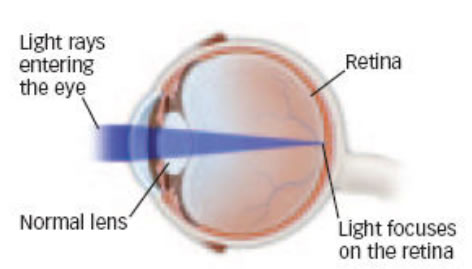
Light rays entering an eye with a normal lens.
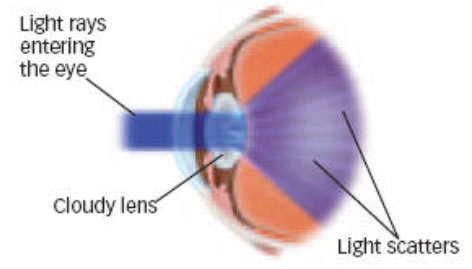
Light rays entering an eye with a cataract. When a cataract forms, the lens of your eye is cloudy.light cannot pass through it easily, and your vision
What causes cataracts?
Cataract development is a normal process of aging, but cataracts also develop from eye injuries, certain diseases or medications. Your genes may also play a role in cataract development.
How can a cataract be treated?
A cataract may not need to be treated if your vision is only slightly blurry. Simply changing your eyeglass prescription may help to improve your vision for a while. There are no medications, eyedrops, exercises or glasses that will cause cataracts to disappear once they have formed. Surgery is the only way to remove a cataract. When you are no longer able to see well enough to do the things you like to do, cataract surgery should be considered.
In cataract surgery, the cloudy lens is removed from the eye through a surgical incision. In most cases, the natural lens is replaced with a permanent intraocular lens (IOL) implant.
What can I expect if I decide to have cataract surgery?
Before Surgery
To determine if your cataract should be removed, your ophthalmologist (Eye M.D.) will perform a thorough eye examination. Before surgery, your eye will be measured to determine the proper power of the intraocular lens that will be placed in your eye. Ask your ophthalmologist if you should continue taking your usual medications before surgery.
You should make arrangements to have someone drive you home after surgery.
The Day of Surgery
Surgery is usually done on an outpatient basis, either in a hospital, an outpatient surgical center, or an ambulatory surgery center. You may be asked to skip breakfast, depending on the time of your surgery.
When you arrive for surgery, you will be given eyedrops and perhaps a mild sedative to help you relax. A local anesthetic will numb your eye. The skin around your eye will be thoroughly cleansed, and sterile coverings will be placed around your head. Your eye will be kept open by an eyelid speculum. You may see light and movement, but you will not be able to see the surgery while it is happening.
Under an operating microscope, a small incision is made in the eye. In most cataract surgeries, tiny surgical instruments are used to break apart and remove the cloudy lens from the eye. The back membrane of the lens (called the posterior capsule) is left in place.
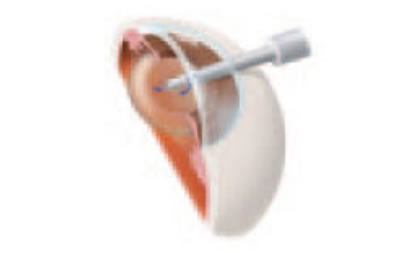
During cataract surgery, tiny instruments are used to break apart and remove the cloudy lens from the eye.
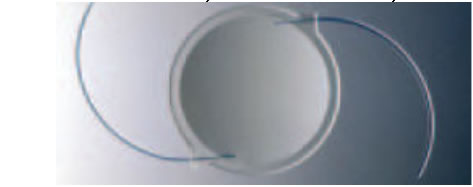
An intraocular lens (iol) implant.
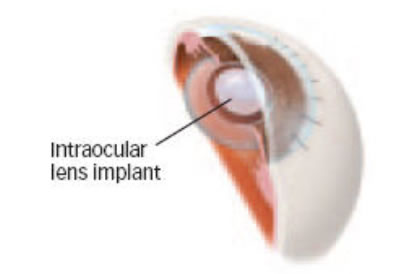
In cataract surgery, the intraocular lens replaces the eye’s natural lens.
After surgery is completed, your doctor may place a shield over your eye. After a short stay in the outpatient recovery area, you will be ready to go home.
Following Surgery
You will need to:
- Use the eyedrops as prescribed
- Be careful not to rub or press on your eye
- Avoid strenuous activities until your ophthalmologist tells you to resume them
- Ask your doctor when you can begin driving
- Wear eyeglasses or an eye shield, as advised by your doctor
You can continue most normal daily activities. Over-the-counter pain medicine may be used, if necessary.
Is a laser used during cataract surgery?
Laser surgery is not used in cataract removal surgery. However, the lens capsule (the part of the eye that holds the lens in place) sometimes becomes cloudy several months or years after the original cataract operation. If the cloudy capsule blurs your vision, your ophthalmologist can perform a second surgery using a laser. During the second procedure, called a posterior capsulotomy, a laser is used to make an opening in the cloudy lens capsule, restoring normal vision.
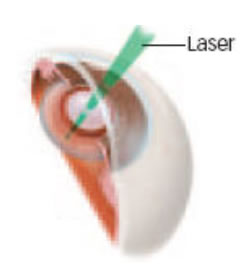
Posterior capsulotomy: a laser is used to make an opening in the cloudy lens capsule.
Will cataract surgery improve my vision?
The success rate of cataract surgery is excellent. Improved vision is achieved in the majority of patients. Only a small number of patients continue to have problems following cataract surgery.
Complications After Cataract Surgery
Though they rarely occur, serious complications of cataract surgery are:
- Infection
- Bleeding
- Swelling
- Detachment of the retina
Call your ophthalmologist immediately if you have any of the following symptoms after surgery:
- Pain not relieved by nonprescription pain medication
- Loss of vision
- Nausea, vomiting, or excessive coughing
- Injury to the eye
Even if cataract surgery is successful, some patients may not see as well as they would like to. Other eye problems such as macular degeneration (aging of the retina), glaucoma or diabetic retinopathy may limit vision after surgery. Even with these problems, cataract surgery may still be worthwhile.




















